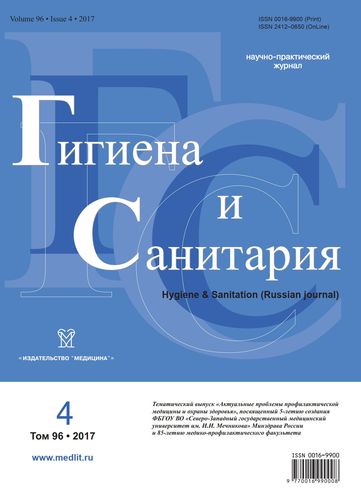HYGIENIC SUBSTANTIATION OF THE SAFETY OPERATION OF THE ENTERPRISE FOR THE PRODUCTION OF POLYVINYL CHLORIDE
- Authors: Fomin M.V.1, Alikbayeva L.A.1, Lukovnikova L.V.1, Sidorin G.I.1, Petrova N.N.1
-
Affiliations:
- I.I. Mechnikov North-Western State Medical University
- Issue: Vol 96, No 4 (2017)
- Pages: 347-351
- Section: OCCUPATIONAL HYGIENE
- Published: 21.10.2020
- URL: https://ruspoj.com/0016-9900/article/view/640566
- DOI: https://doi.org/10.47470/0016-9900-2017-96-4-347-351
- ID: 640566
Cite item
Full Text
Abstract
About the authors
M. V. Fomin
I.I. Mechnikov North-Western State Medical University
Author for correspondence.
Email: noemail@neicon.ru
Russian Federation
L. A. Alikbayeva
I.I. Mechnikov North-Western State Medical University
Email: alikbaeva@mail.ru
Russian Federation
L. V. Lukovnikova
I.I. Mechnikov North-Western State Medical University
Email: noemail@neicon.ru
Russian Federation
G. I. Sidorin
I.I. Mechnikov North-Western State Medical University
Email: noemail@neicon.ru
Russian Federation
N. N. Petrova
I.I. Mechnikov North-Western State Medical University
Email: noemail@neicon.ru
Russian Federation
References
- Левин А.Л. Перспективы развития производств винилхлорида. В кн.: Шаронова З.В., ред. Вопросы гигиены и охраны труда, промышленной токсикологии и профпатологии в производствах сырья для синтетических смол, каучука и пластмасс. Горький; 1973: 3-5.
- Заиков Г.Е. Деструкция и стабилизация полимеров. М.: МИТХТ; 1990.
- Уилки Ч., Саммерс Дж., Даниэлс Ч., ред. Поливинилхлорид. Пер. с англ. СПб.: Профессия; 2007.
- Дорогова В.Б., Мещакова Н.М., Журба О.М. Оценка производства винилхлорида и поливинилхлорида как источников загрязнения воздушной среды рабочих помещений и их влияние на организм работающих. Бюллетень Восточно-Сибирского научного центра Сибирского отделения Российской академии медицинских наук. 2008; (1): 83-8.
- Рахманин Ю.А., Новиков С.М. Оценка риска здоровью человека как основа для дальнейшего развития экологии человека и гигиены окружающей среды. Гигиена и санитария. 2003; 82(3): 5-13.
- Сидорин Г.И., Луковникова Л.В., Фролова А.Д. Характеристики биологического окисления - критерий экологической нагрузки различными химическими веществами на организм. В кн.: Экологическая безопасность городов: материалы конференции. СПб.; 1993: 177-8.
- Данишевский С.Л., Брайтман А.Я., Калинин Б.Ю., Комарова Е.Н., Крынская И.Л. Токсикологическая и санитарно-химическая характеристика пластических масс. В кн.: Гарбар М.И., Акутина М.С., Егорова Н.М., ред. Справочник по пластическим массам. Том 1. М.: Химия; 1967: 406-54.
- Лемешевская Е.П., Жукова Е.В. Вопросы гигиены труда в крупнотоннажном производстве поливинилхлорида. Медицина труда и промышленная экология. 1995; (6): 17-20.
- Фомин М.В. Гигиеническая оценка выбросов в атмосферный воздух предприятий по производству поливинилхлорида. В кн.: Актуальные проблемы медицины и биологии: материалы научно-практической конференции. СПб.: СПбГМА им. И.И. Мечникова; 2010: 92-3.
- Lim K.S., Rink K.G., Glass H.G., Soaje-Echague E. A method for the evaluation of cumulation and tolerance by the determination of acute and subchronic median effective doses. Arch. intern. Pharmacodyn, 1961. 130(3-4): 336-353
- Сидорин Г.И., Луковникова Л.В., Фролова А.Д. Ингибиторный анализ биологического окисления как методический прием ускоренного прогнозирования метаболизма и механизма токсического действия промышленных ядов. В кн.: Актуальные вопросы общей и корабельной токсикологии: материалы конференции. СПб.; 1994.
- Саноцкий И.В., Уланова И.П. Критерии вредности в гигиене и токсикологии при оценке опасности химических соединений. - М.: Медицина, 1975. - 325 с.
Supplementary files









